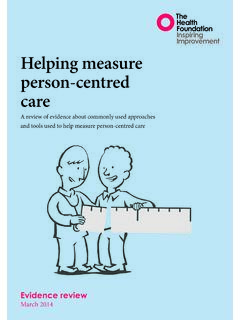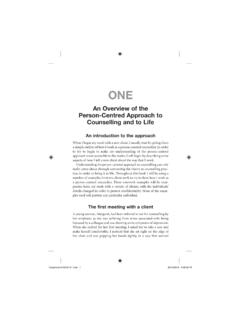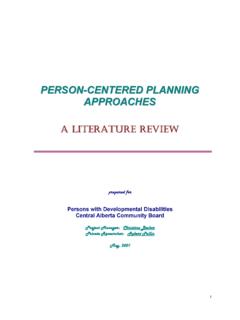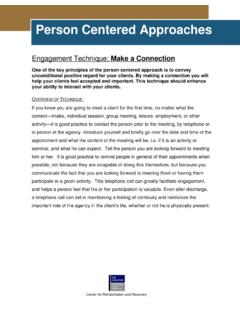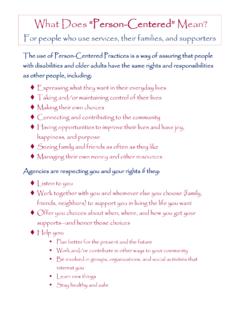Transcription of PERSON-CENTERED His core theme in therapy is non ...
1 1 PERSON-CENTEREDTHERAPYP sychology 460 Counseling and InterviewingSheila K. Grant, :Father of Humanistic Movement Carl Rogers is the father of the humanistic movement inpsychotherapy His core theme in therapy is non-judgmental listening &acceptance of the client, better known as unconditionalpositive regard His therapeutic approach is known as the PersonCentered therapy , which is based on the concepts ofhumanistic psychology & shares many of the concepts ofExistentialism Both of these concepts share the idea that the client canmake positive & constructive choices His approach is also based on the theory that people are"trustworthy" and can solve their own problems withoutdirect intervention from the therapistCarl Rogers: Bio Carl Rogers was born January 8, 1902 in OakPark, Illinois in a very strict, religious family He was a shy, studious boy He enrolled in agricultural science at theUniversity of Wisconsin, but transferred to UnionTheological Seminary in Chicago Disillusioned, he withdrew and entered theTeachers College at Columbia University, ahotbed for liberal, social ideasCarl Rogers: Bio Rogers founded client- centered psychotherapy &pioneered in the development of scientificmethods for studying psychotherapeuticoutcomes & processes In 1942 Rogers became 1st therapist to record &transcribe therapy sessions verbatim, a practicenow standard He published his ideas & clinical results inseveral books, including On Becoming a Personwhich made him a well-known figure inAmerican psychologyCarl Rogers.
2 Bio Rogers taught at the University of Chicago, Ohio StateUniversity, & the University of Wisconsin at Madison Rogers's client- centered therapy is among the mostinfluential & widely employed techniques in modern psychology This is the type of therapy cliched by phrases such as"how do you feel about that?" from the psychologist Bob Newhart, another Oak Park native, portrayed aRogerian-style psychologist on the original "Bob NewhartShow In his later years Rogers championed humanistic causesincluding racial harmony, and world peace. He wasnominated for the Nobel Peace Prize in 1987 Carl Rogers: Bio Carl Rogers died February 4, 1987 "Experience is, for me, the highest authority. Thetouchstone of validity is my own experience. No otherperson's ideas, and none of my own ideas, are asauthoritative as my experience. It is to experience that Imust return again and again, to discover a closerapproximation to truth as it is in the process of becomingin me.
3 Neither the Bible nor the prophets --neither Freudnor research neither the revelations of God nor man --can take precedence over my own direct experience. Myexperience is not authoritative because it is infallible. It isthe basis of authority because it can always be checked innew primary ways. In this way its frequent error orfallibility is always open to correction."2 Carl Rogers: Bio Rogers plays an important historical role inthe development of psychology andpsychotherapy He was one of the first, if not the first,psychologist to propose a comprehensivetheory about psychotherapy Prior to Rogers, almost all forms of therapycentered around psychiatry andpsychoanalysisPerson- centered therapy (A reaction against the directive and psychoanalytic approaches) Challenges: The assumption that the counselor knowsbest The validity of advice, suggestion, persuasion,teaching, diagnosis,and interpretation The belief that clients cannot understand andresolve their own problems without directhelp The focus on problems over personsPerson- centered theoryCarl Rogers OVERVIEW SELF-DIRECTED GROWTH THE RELATIONSHIP BETWEEN THE HELPERAND THE CLIENT FUNDAMENTAL CONCEPT IS TRUST THE ACTUALIZING TENDENCY IS PRESENTIN EVERY HUMAN INDIVIDUALS ARE ARCHITECTS OF THEIROWN LIVESQ uestions: In what ways would you say that youhave been the architect of your life?
4 Inthe people you have known best, haveyou recognized a self-actualizing tendency? Is it hard for you to have confidence inanother person s ability to find their ownway, with you serving as an ally instead ofa guide? PERSON-CENTERED therapy Emphasizes: therapy as a journey shared by two falliblepeople Person s innate striving for self-actualization Personal characteristics of therapist & thequality of therapeutic relationship Counselor s creation of a permissive, growthpromoting climate People are capable of self-directed growth ifinvolved in a therapeutic relationshipKey Concepts Rogers believes that, under nurturingconditions a client will be able to moveforward & resolve their own issues One can direct one s own life Congruence both the therapist s and theclient s Unconditional positive regard Accurate empathetic understanding3A Growth-Promoting Climate Congruence - genuineness or realness Unconditional positive regard-acceptance and caring.
5 But not approvalof all behavior Accurate empathic understanding an ability to deeply grasp the client ssubjective world Helper attitudes are more important thanknowledgeA Growth-Promoting Climate Congruence - genuineness or realness The helper does not deny his or her own feelings:the opposite of hiding behind a professional mask. I find that I am closest to my inner, intuitive self,when I am somehow in touch with the unknown inme, when perhaps I am in a slightly altered state simply my presence is releasingand helpful. (Rogers) Thought: Rogers language is somewhat strange here, but canyou conceptualize a more mystical dimension to helpingsomeone? Have you ever had this experience of being attunedto your intuitive self as a helper or just a friend?A Growth-Promoting Climate Unconditional positive regard-acceptance and caring, but notapproval of all behavior Related Terms: Acceptance of the other s reality with kindness Non-possessive caring Prizing Non-judgmental attitude Q: Have you ever prized someone?
6 Could you consistently prize a client, even if that person seemed to be without manystrengths or successes in life?A Growth-Promoting Climate Accurate empathic understanding an ability to deeply grasp the client ssubjective world Helper attitudes are more important thanknowledge Empathy is a consistent, unflaggingappreciation of the experience of the other. It is active attention to the feelings of theclient It involves warmth and genuinenessBasic Characteristics In the Person centered approach thefocus is on helping the client discovermore appropriate behavior by developing self-awareness & ways to fully "encounter reality" Through this encounter the client gainsinsight of themselves & the worldSix Core Conditions (necessary & sufficient for personality changes to occur)1. Two persons are in psychological contact2. The first, the client, is experiencing incongruency3.
7 The second person, the therapist, is congruent orintegrated in the relationship4. Therapist experiences unconditional positive regardor real caring for the client5. Therapist experiences empathy for the client sinternal frame of reference and endeavors tocommunicate this to the client6. Communication to the client is, to a minimal degree,achieved4 The Therapist Therapists are used as instruments of changebut are not to direct the change in client Therapist helps develop an environment inwhich the client can grow Through attitudes of genuine caring, respect,and understanding the client is able to lettheir defenses down & become more self-aware Therapist reflects client s view of the world(Phenomenological approach )The Therapist The Therapist must be: congruent able to approach client with unconditional positiveregard demonstrate accurate understanding and empathy Focuses on the quality of the therapeuticrelationship Serves as a model of a human being strugglingtoward greater realness Is genuine, integrated, and authentic, without afalse front Can openly express feelings & attitudes that arepresent in the relationship with the clientINCONGRUENCEREAL SELFIDEAL SELFT herapeutic Process Main focus is on the person & not on theperson's problems This allows the client to reconnect withhis/herself.
8 Client is assisted in therapy so that they candeal with current problems as well as problemsthat develop in the future Focuses on helping a person become aware oftheir true self & develop congruencyBasic assumptions about theclient s SELF-REGARD the focus is to help theperson feel significantly more positive LOCUS-OF-EVALUATION clients tend toworry too much about what others think; thegoal is to have the client be less dependent onother, externalized values and standards, s evaluations of the client EXPERIENCING rather than a rigid mode,the goal is to have an attitude of opennessClient s Experience Through therapy client is able to let downhis/her defenses & become more true tohim/her selves They gain perception into themselves,which allows them to better understand &accept others5 Summary Helper is to be present & accessible, in themoment-to-moment interchange Focus is on the phenomenological world ofthe client Helper should strive to be as transparent& honest as possible Focus is on the present.
9 Rather thanexplaining the pastLimitations toPerson- centered therapy Therapist could become so dogmatic inapplication of reflective approach that they fail to be real with client & irritate them by repeating their words in anattempt to make reflective statements Discounts significance of client s past Limited use with non-verbal clientsRoger s Rationale We are born into a world of Hierarchial Needs Degree to which, and how, these needs are metforms our outlook on life & our Self-Concept We have an inherent tendency toward our IdealSelf called Self-Actualization Given proper nurturance, our Self-Concept (whowe think we are based on others' expectations)will be Congruent with our Ideal Self However, our interactions with others and theenvironment can lead to Incongruence betweenour Self-Concept and Ideal SelfRoger s Rationale We learn that we are rewarded & valued forcertain behaviors, ( , when I cry I am fed,when I smile, I am cuddled) As we grow, conflicts occur in which we mustchoose between organismic needs/urges &behaviors that lead to reward & acceptance This leads to Conditions of Worth where we feelmore worthy when we become the person weperceive that caretakers want us to be, even if itis not genuinely who we areRoger s Rationale We learn to selectively perceive experiences & eventsthat fit our Self-Concept (as defined by our perceivedConditions of Worth) and We may ignore or distort experiences that do not When significant experiences (particularly emotions)
10 Are repeatedly distorted or denied Incongruencebetween our Self-Concept & Ideal Self can lead toPsychological Maladjustment ( , narcissisticpersonality disorder) When in a state of Incongruence, many experiencesare perceived as threats causing anxiety & raising ourdefenses This may lead to further distortions, moreIncongruence, & maladjustmentRoger s Rationale However, if we are able to accurately perceiveexperiences & feelings they can be integratedinto our self-structure making us moreCongruent This occurs when we no longer perceive threatsthat were learned as part of our Conditions ofWorth Rogers believed that if we feel UnconditionalPositive Regard from a significant other ( ,counselor) it will allow us to become fully awareof our feelings6 Roger s Rationale As we increase our Availability ofAwareness of experiences & true feelingswe integrate them into our self-structure,replacing some of the values & Self-Concept that was based on the demandsof others & our own distortions This process leads to Congruence betweenour Self-Concept & our Ideal Self and Accelerates our natural process of Self-ActualizationDefinitions Self-Actualization: The inherent tendency ofpersons to develop all of their capacities; To beall we can be Self-Concept: Who we think we are.










